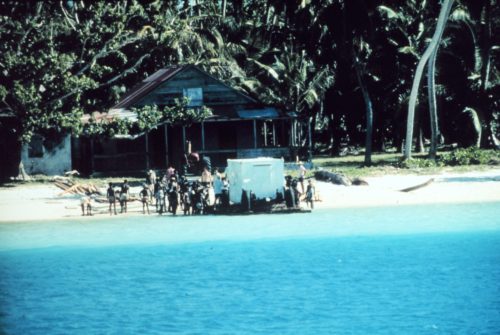by John Milton (1608 – 1674)
In either hand the hast’ning angel caught
Our ling’ring parents, and to th’ eastern gate
Led them direct, and down the cliff as fast
To the subjected plain: then dissapeared.
They looking back, all th’ eastern side beheld
Of Paradise, so late their happy seat,
Waved over by that flaming brand, the gate
With dreadful faces thronged and firey arms:
Some natural tears they dropped, but wiped them soon;
The world was all before them, where to choose
Their place of rest, and Providence their guide:
They hand in hand with wand’ring steps and slow,
Through Eden took their solitary way.
This is what came to mind as I read the latest news about the people from the Chagos Archipelago.
The Mauritius president has threatened to leave the Commonwealth in protest at the UK’s “barbarous” treatment of the people of the Chagos Islands.
I first became familiar with the strange Anglo-American expansion onto Diego Garcia, a Chagos island, when I studied Cold War policies and the decision of the US in the 1960s to migrate their military base out of Ethiopia. Few details were available then, and it wasn’t the focus of my studies, but as time goes on the complete madness of some US and UK security decisions are starting to become shockingly clear.
Diego Garcia was not just a lone desolate spot in the sea that the US developed to protect the free world from the Red threat, as most reports used to say. It really was a place thousands of people called home before American soldiers landed and stripped them of their property, identity and livelihood.
Consider the Guardian’s research and subsequent comment published in 2004 called Paradise cleansed:
To get rid of the [Diego Garcia] population, the Foreign Office invented the fiction that the islanders were merely transient contract workers who could be “returned” to Mauritius, 1,000 miles away. In fact, many islanders traced their ancestry back five generations, as their cemeteries bore witness. The aim, wrote a Foreign Office official in January 1966, “is to convert all the existing residents … into short-term, temporary residents.”
What the files also reveal is an imperious attitude of brutality. In August 1966, Sir Paul Gore-Booth, permanent under-secretary at the Foreign Office, wrote: “We must surely be very tough about this. The object of the exercise was to get some rocks that will remain ours. There will be no indigenous population except seagulls.” At the end of this is a handwritten note by DH Greenhill, later Baron Greenhill: “Along with the Birds go some Tarzans or Men Fridays …” Under the heading, “Maintaining the fiction”, another official urges his colleagues to reclassify the islanders as “a floating population” and to “make up the rules as we go along”.
I’m now curious to see Stealing a Nation.
Award-winning reporter John Pilger exposes how the British Government expelled the population of a group of islands, including Diego Garcia, so the US could build a military base.
[…]
In the 1960s, the government of Harold Wilson struck a secret deal with the United States to hand over Diego Garcia. The Americans demanded that the islands be “swept” and “sanitized”. Unknown to Parliament and to the US Congress, the British government plotted with Washington to expel the entire population – in secrecy and in breach of the United Nations Charter.
If it were justified, in the name of security and global freedom, would such an expulsion really have been necessary, let alone classified as secret?
That’s a tough question. Maybe I should just ask, back to Milton’s poetry, what will the Chagos’ Paradise Regained story look like?
Update 2018: NOAA has posted an image of US personnel bringing equipment onto Diego Garcia helped by Ilois (Chagossians) in 1971.
Location: Chagos, Diego Garcia Island (Image ID: 6158, Geodesy Collection)
Source: https://photolib.noaa.gov/Collections/Geodesy/emodule/519/eitem/6158
